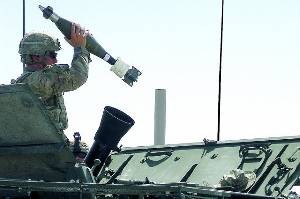Articles >>
Stryker units in Afghanistan now equipped with precision mortars
Category: Defence Industry

PICATINNY ARSENAL, N.J. -- The first-ever Accelerated Precision Mortar Initiative round fired from a Stryker vehicle in Afghanistan accomplished what few conventional 120mm high-explosive mortars can achieve: a direct hit on a target with the first round fired. But when firing the Army's new precision-guided cartridges, this is the standard. First fielded to dismounted troops in Afghanistan last April, Picatinny's Program Executive Office for Ammunition is now fielding the 120 mm precision rounds to Stryker Brigade Combat Teams. While Accelerated Precision Mortar Initiative, or APMI, will not replace standard 120 mm mortars, its accuracy will allow a commander the ability to defeat a target with precision if there is danger of collateral damage. APMI will be fired from the Army's new Stryker Double-V Hull Mortar Carrier Vehicle, or MCVV. The Stryker MCVV is used to provide high-angle mortar fire to support operations in complex terrain and urban environments. It now can fire APMI precision-guided mortars as well as conventional 120mm rounds. "Integration of APMI into the Stryker platform gives the troops greater flexibility and increased maneuverability," explained Ted Hom, APMI product director. The dismounted 120 mm mortar systems in Afghanistan are often kept at mortar positions in Forward Operation Bases and Combat Outposts throughout the country. Now that APMI has been integrated with a mobile platform, the battle space where the APMI round can be used has increased. Hom said that when fired from Stryker, APMI will "have the same precision, but on a platform that can easily go wherever needed." With APMI's pinpoint accuracy and the Stryker MCVV's survivability against improvised explosive devices,known as IEDs, maneuver commanders now have a very accurate weapon against insurgents. The APMI cartridge has a requirement of 10 meters CEP, or Circular Error Probable. APMI combat rounds fired in Afghanistan are exceeding the requirement, Hom said. Ten meters CEP means that if you drew a circle around a target at 10 meters radius, the rounds have to fall inside the circle 50 percent of the time. TRAINING THE SOLDIERS
PEO Ammunition's Product Manager for Guided Precision Munitions and Mortar Systems, or PdM GPM2S, conducted the first Stryker MCVV combined training and live-fire exercise in June with an infantry division of the 3-2 Stryker Brigade Combat Team, higher headquarters 5-20 Infantry and B Troop 1-14 Cavalry, who are currently supporting an Airborne Brigade Combat Team in Afghanistan. "The biggest thing for us is that this is the first time maneuver commanders will have an incredibly accurate munition that is perfect for the targets we see in our area of operation, such as IED emplacers, historic Taliban fighting positions, and enemies close to troops in the open," explained 1st Lt. Eric Birdsley. "Our responsiveness to threats is greatly increased because commanders can approve the use of this capability," Birdsley added. "Also, due to the small battle space in our AO (Area of Operation) the ability to shoot APMI at closer ranges than the Excalibur gives us a close-range precision capability we did not previously have." Many Soldiers who attended the initial training said they were impressed by the performance of the round, especially since many of them had never seen a direct hit on a target. "After today's successful live fire, we are really impressed with the APMI system," said Platoon Leader 1st Lt. Brian McGillivray. "The first round effect it brings alleviates any concerns with accuracy of mortars," McGillivary said. "As long as we follow proper procedures, we can pretty much hit anything. Now that this live fire has demonstrated APMI's ability to get a first-round effects of the target, our brigade can start relying on the round." The research, development and integration of APMI onto Stryker is a collaboration of PEO Ammunition, the Armament Research, Development and Engineering Center, Joint Munitions Command and Project Manager Stryker Brigade Combat Team.
By Audra Calloway and Breanna Merenda |
US Army |
BAE Systems` CV90 increases lethality by testing SPIKE LR anti-tank guided missile
14.01.2020
General Dynamics Land SystemsľUK showcases adaptable Foxhound vehicle at DSEI 2019
23.09.2019
Otokar offers solutions with technology transfer and local manufacturing models
13.09.2019
Supacat, Rheinmetall and SCISYS partnership showcases new High Mobility Integrated Fires Capability
12.09.2019
STRYKER ICV (Wheeled armoured personnel carrier)
STRYKER M1129 MC (Mortar vehicle)
Dragon Fire/Box Mortar (Self-propelled mortar)
Stryker ICV (Wheeled armoured personnel carrier)
STRYKER (Self-propelled howitzer)
STRYKER IFV M1126 (Infantry fighting vehicle)
STRYKER M1127 RV (Wheeled armoured personnel carrier)
STRYKER M1130 CV (Command vehicle)
STRYKER M1132 ECV (Engineer vehicle)
STRYKER M1133 (Ambulance vehicle)
STRYKER M1134 (Self-propelled antitank guided missile system)
STRYKER M1135 NBCRV (Nuclear/biological/chemical reconnaissance vehicle)
STRYKER M1132 (Mine clearing vehicle)
STRYKER XM1128 MGS (Fire support vehicle)
STRYKER XM1134 (Self-propelled antitank guided missile system)
STRYKER M1131 FSV (Fire support vehicle)
STRYKER M1133 MEV (Ambulance vehicle)
Ň╠1296 Stryker ICV Dragoon (Modernization of the vehicle)
Discuss
